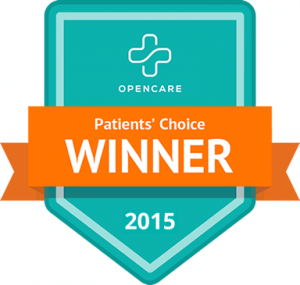Q: What are Scleral Contact Lenses?
A: Scleral lenses are custom made lenses that rest on the sclera, the whites of your eyes. The size of the lens offers great vision that isn't possible with any other vision solution. These lenses provide a solution for those patients who can't wear other types of contact lenses due to dry eyes, complications from LASIK surgery, kerataconus, and other eye issues.
Q: What eye drops do you recommend for dry eye syndrome?
A: There are 2 prescription eyedrops on the market right now, Restasis and Xiidra. Both eyedrops reduce inflammation. Restasis takes longer for patients to notice symptom abatement, while Xiidra tends to provide relief faster. After a thorough eye exam, focusing on your dry eye symptoms, our eye doctor will be able to determine which eye drop would be best for your eye condition.
Q: What can I do about Digital Eye Strain?
A: We can help! There are various eyeglass lenses and lens coatings for people of all ages to relieve digital eye strain and ease fatigue after extended reading or computer use. Lens treatments, such as anti-reflective and blue light blocking coatings, protect your eyes and increase comfort. We also prescribe many different types of contact lenses to reduce reading discomfort and make it easier to switch focus from near to far.
Q: What are the common symptoms of OCULAR allergies?
A: Excessive tearing, frequent eye rubbing, constant irritation especially in the corners of your eyes closest to the nose, lid swelling or puffy eyes, and red or pink eyes are some of the most common ocular allergy symptoms.
Q: What is Amblyopia?
A: Sometimes called Lazy eye, it is the underdevelopment of central vision in one or sometimes both eyes; it also prevents both eyes from working together.
Q: What are multifocal lens implants?
A: Multifocal lens implants are often used in cataract surgery to reduce the dependency upon glasses for both distance and near vision after the surgery is completed. As with other medical technology, not everyone will be a good candidate for this type of surgical implant. Patients with corneal scarring or significant astigmatism, as well as surgical candidates with eye diseases such as diabetic retinopathy, glaucoma and macular degeneration, may not receive the full benefit from these lenses. Your eye care professional can help determine if this lens implant option is right for you.
Q: My child saw 20/20 at their school physical. That's perfect vision for back to school, right?
A: Maybe! 20/20 only tells us what size letter can be seen 20 feet away. People with significant farsightedness or eye muscle imbalances may see "20/20", but experience enough visual strain to make reading difficult. Eighty percent of learning is visual so include a thorough eye exam in your child's Back-to-School list.
Q: My child is struggling in school. Should I have his/her eyes examined?
A: A comprehensive eye examination by an optometrist can often determine if there are visual issues interfering with a child's ability to perform in school. Many visual symptoms, some obvious, others less so, can contribute to a child's poor academic achievement. Some of these issues can be alleviated with a good pair of eyeglasses while others may require vision therapy. The doctors at our eye clinic are trained in the diagnosis of vision related learning problems.
Q: Is too much computer or hand-held device use bad for my child’s eyes?
A: The last few years have seen a radical shift in how our children use their vision. More and more time is spent looking at an electronic screen; TV, computer, cell phone, game device, and so on. Vision scientists have long pointed out that excessive near point tasks can lead to increased myopia (nearsightedness) in children, eyestrain, and headaches. Combined with the potentially damaging effect of the blue light these screens emit, you have the possibility of a dangerous situation. We recommend a common-sense approach. First, limit the time your child has to electronic media. Psychologists, educators, and doctors all agree: too much is not good. Second, practice the 20/20/20 rule. For every twenty minutes of near point tasks, take twenty seconds and look at something twenty feet or more away. In short, take frequent rest breaks. Third, use lenses that are designed for your particular activity. Having the correct eyeglass or contact lens prescription is always the place to start. There are lenses and coatings that not only provide the proper focus, but also block unwanted glare and limit the amount of damaging blue light.
Q: What are progressive computer glasses?
A: Progressive lenses let people clearly see objects at multiple distances by incorporating a prescription for distance, midrange, and near vision. Since they are used full time for all activities like driving and watching TV, the upper portion you see through when looking straight out is for distance vision; you must lift your chin a little to see the computer through the midrange portion. Progressive computer glasses, however, are made for heavy computer use. When looking straight ahead, your eyes focus on your computer and when you look down, you can read. Some lenses can focus out 5 feet, others out to 10 feet. Generally speaking, progressive computer lenses are for computers and reading due to their larger midrange zone and are not recommended for driving. They can be perfect for anyone who spends long hours in front of a monitor.
Q: We have many choices today to correct our vision. What do you recommend as the earliest age for contact lenses?
A: This is very patient-specific and task-specific. Once the parent and child agree on the goals, and if the child is responsible enough for contacts, we can begin assess each situation individually. For example, disposable contacts may be used specifically for a sport, as needed.
Q: What type of contact lenses are best for children?
A: We recommend daily disposable contact lenses for children. Daily disposables allow the patient to have a sterile, fresh lens every day. Many infections occur when patients do not properly disinfect their contact lenses with solution. Daily disposables eliminate this step completely, and help decrease the risk for contact-lens-related problems. Also, you won't have to keep track of when the contacts need to be replaced, as they are thrown away at the end of every day, instead of after two weeks or a month.
Q: What are the pros of daily disposable contact lenses?
A: Daily disposable contact lenses are great for many reasons. The risk of infection is reduced, because a new sterile lens is used everyday, and there is no need to clean the lens or the case. This is also a great option for patients who have allergies, contact lens solution sensitivities, or dry eye, as it eliminates the buildup of contaminants on the lenses, which can exacerbate those problems. Dailies make for a low-maintenance and comfortable option for almost any patient!
Q: I wear multifocal eyeglasses. Is it possible for me to wear contact lenses?
A: Of course! There are several different types of multifocal contact lenses, and we specialize in fitting each patient with the one that will be the most comfortable and correct his or her vision the best. There are bifocal, multifocal, and monovision lenses to choose from, and they're available in Rigid Gas Permeable (RGP) or soft contact lenses. Depending on your prescription and what is most comfortable, we will fit you with a contact lens that will provide you with great vision. There are 3 good options for patients who want to use contact lenses to correct distance and near vision at the same time. Most patients can be successful with either multifocal contact lenses or monovision. Both of those options would make you glasses free. Some people prefer having contact lenses for distance and then wearing "cheaters" when they need to read. The right decision is usually based on your lifestyle and visual demands.
Q: Can I swim with contacts in?
A: No, there are a lot of bad bugs in the waters and one of the worst is known as pseudomonas, which is a kind of bacteria that lives in the water, and adheres to contact lenses. A pseudomonas infection can cause major corneal damage within 24 hours.
Q: What Is Convergence Insufficiency?
A: Convergence Insufficiency (CI) is a visual condition where the eyes are not able to comfortably focus on near-vision tasks, which makes reading difficult or impossible. The condition tends to make kids see double, lose their place, read slowly, and get tired after a short time reading. Many children with CI avoid books, struggle in school, take very long to do their homework, and may even be misdiagnosed as having ADD/ADHD. Convergence Insufficiency patients are also more prone to dizziness and vertigo. The best treatment for CI is vision therapy. These exercises help the person have better control of their eyes, allowing them to enjoy reading and do well at school.
Q: Whenever I close my eyes, I see flashes of light in my vision, should I be concerned?
A: Flashes of light in your vision could be a very dangerous sign! Something is tugging at your retina and eliciting these flashes of light. Sometimes it could be the vitreous humor pulling at the retina in aging vitreous degeneration, but sometimes it could mean a dangerous retinal tear or detachment. Detachments need to be treated within 24 hours for the best prognosis in preventing permanent vision loss.
Q: I have "spots" floating around in my eye. Should I be worried?
A: Spots and floaters are usually harmless. However, in some cases it can be a sign of a retinal detachment or bleeding. Anyone experiencing symptoms of flashing lights and flashing spots should contact our office immediately for a detailed eye exam.
Q: What’s the difference between vision insurance and eye insurance?
A: “Vision insurance” really isn’t insurance, but rather a benefit that covers some of your costs for eyewear and eye care. It is meant to be used for “routine” care when you aren’t having a problem but want to be sure everything is OK, like having an annual screening exam with your Primary Care Physician. It often, but not always, includes a discount or allowance toward glasses or contact lenses. It is usually a supplemental policy to your medical health insurance. Medical health insurance covers, and must be used when an eye health issue exists. This includes pink eye, eye allergies, glaucoma, floaters, cataracts, diabetes, headaches, and many other conditions. Blurry vision is covered medically if it relates to a medical condition, for example the development of a cataract. For some reason, however, it is considered non-medical if the only finding is the need for glasses or a change of prescription. Of course you can’t know this until you have the exam. In this case, with vision coverage, you would only be responsible for your co-pay, but with medical coverage without vision coverage, you’d be responsible for the usual charge.


